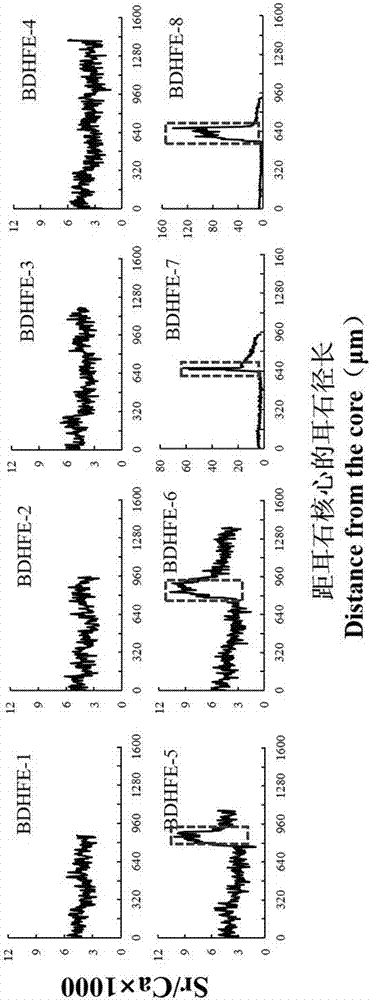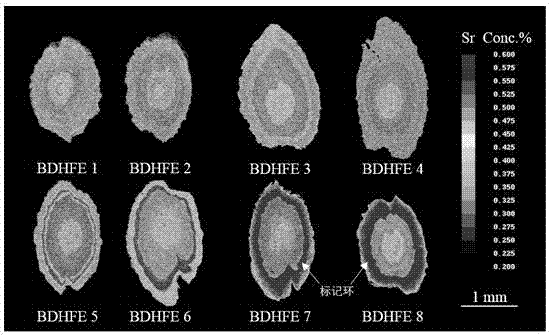Flounder-otolith-element marking method
A marking method and technology for flounder, which are applied in fish farming, additional food elements, animal feed, etc., can solve the problems of low retention rate, large damage to fish body, influence on survival rate of marked fish, etc. The effect of low lethality
- Summary
- Abstract
- Description
- Claims
- Application Information
AI Technical Summary
Problems solved by technology
Method used
Image
Examples
specific Embodiment approach
[0021] A specific embodiment of a method for marking otolith elements of flounder fish of the present invention comprises the following steps:
[0022] (1) Mix strontium chloride hexahydrate evenly with fish feed, so that the fish feed contains strontium element, and obtain marked feed;
[0023] (2) using the marked feed to feed the flounder to be marked;
[0024] (3) Feed the marked feed 1-2 times a day for at least 3 days;
[0025] (4) The content of strontium chloride hexahydrate should account for at least 0.8% of the total mass of the marked feed.
[0026] Preferably, in the step (3), the marked feed is fed twice a day, and the feeding time is 4-10 days; in the step (4), the content of strontium chloride hexahydrate accounts for 1%-10%.
[0027] Below are 3 specific embodiments of the present invention:
Embodiment 1
[0029] (1) Make marked feed: Fish feed is made of pellet feed, with bio-alginate as the binder, and 1kg of pellet feed uses 10-15g of bio-alginate. Dissolve 8g of strontium chloride hexahydrate and 10-15g of bio-algae in 100ml of pure water, mix well, pour into a watering can, evenly spray on 1kg of pellet feed, and dry at room temperature for 24 hours. The pellet feed used in the experiment is Dongwan feed, and the specifications are C0-C3;
[0030] (2) Use marked feed to feed the flounder to be marked, and ensure that there is no residual bait;
[0031] (3) Feed the marked feed once at 8:00 am and 2:00 pm every day (or only feed the marked feed once at 6:00 am every day), and the amount of single feeding is 2%-3% of the total weight of the fish Feeding, feeding time is 10 days; the initial average weight of the experimental flounder fish is 2.64g, and the average weight after 30 days of recovery is 10.89g;
[0032] (4) The content of strontium chloride hexahydrate accounts...
Embodiment 2
[0035] (1) Make marked feed: Fish feed is made of pellet feed, with bio-alginate as the binder, and 1kg of pellet feed uses 10-15g of bio-alginate. Dissolve 32g of strontium chloride hexahydrate and 10-15g of bio-algae in 100ml of pure water, mix well, pour into a watering can, evenly spray on 1kg of pellet feed, and dry at room temperature for 24 hours. The pellet feed used in the experiment is Dongwan feed, and the specifications are C0-C3;
[0036] (2) Use marked feed to feed the flounder to be marked, and ensure that there is no residual bait;
[0037] (3) Feed the marked feed once every day at 8:00 am and 2:00 pm. The single feeding amount is 2%-3% of the total fish body weight, and the feeding time is 3 days; the initial average weight of the experimental flounder fish is 2.51g, and the average weight after 30 days of recovery is 10.01g;
[0038] (4) The content of strontium chloride hexahydrate accounts for 3.2% of the total mass of the marked feed;
[0039] (5) Use ...
PUM
 Login to View More
Login to View More Abstract
Description
Claims
Application Information
 Login to View More
Login to View More - R&D
- Intellectual Property
- Life Sciences
- Materials
- Tech Scout
- Unparalleled Data Quality
- Higher Quality Content
- 60% Fewer Hallucinations
Browse by: Latest US Patents, China's latest patents, Technical Efficacy Thesaurus, Application Domain, Technology Topic, Popular Technical Reports.
© 2025 PatSnap. All rights reserved.Legal|Privacy policy|Modern Slavery Act Transparency Statement|Sitemap|About US| Contact US: help@patsnap.com


